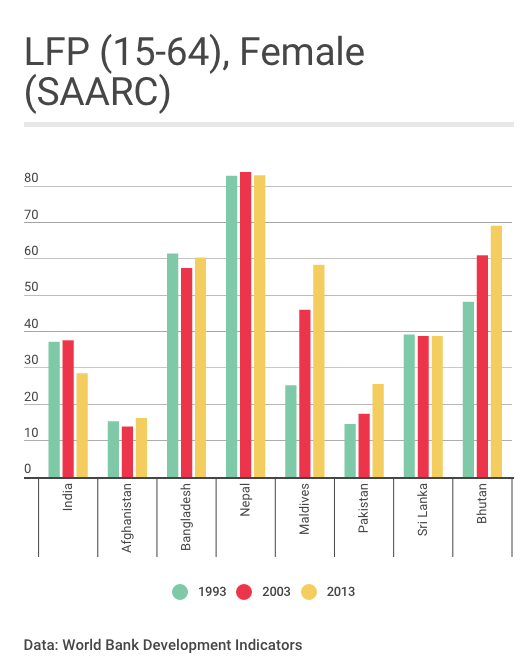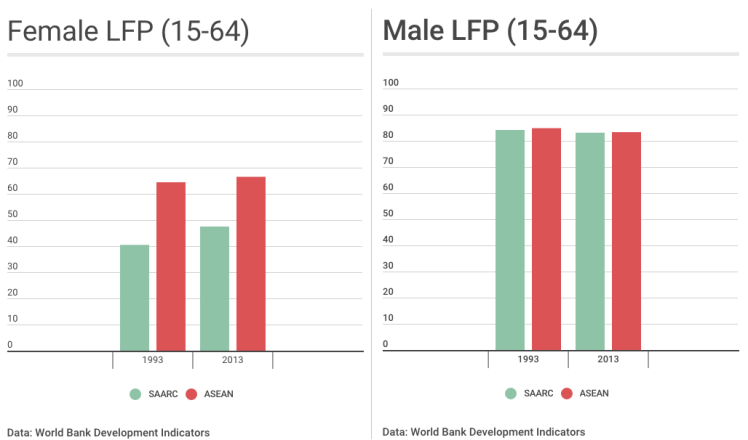Higher labor force participation is a driver of economic growth in any given economy. Results of a new simulation model suggest that closing the gender gap could generate a 30% increase in the per capita income of a hypothetical average Asian economy in one generation. It not only provides more human resources to the economy, but also empowers women by giving them purchasing power. Sen (1999) focuses on two aspects of labor force participation: The well-being aspect is centred on the enhancement of women’s welfare and the agency aspect sees women as active agents of change in their role as the dynamic promoters of social transformations that can alter the lives of both women and men. Women’s labour market participation is determined to a large extent by caste, religion, marital status, and other sociocultural norms, which operate at multiple levels in society and restrict women’s mobility and access to wage employment in the formal labour market. The constraints faced by women to enter the workforce need to be evaluated and corrected.
 Various studies (Rahman 2011, Siddika 2013) compare ASEAN and SAARC in order to comparatively analyze the success of managing conflicts in their respective regions. Others like Sinha (2010) compare the economic structure and trade benefits of the two regions. Female labor force participation constitutes an important factor of economic development because female LFP is a driver of growth and therefore, participation rates indicate the potential for a country to grow rapidly. Thus, it is important to assess and compare LFP rates in the region and take lessons for policy measure interventions.
Various studies (Rahman 2011, Siddika 2013) compare ASEAN and SAARC in order to comparatively analyze the success of managing conflicts in their respective regions. Others like Sinha (2010) compare the economic structure and trade benefits of the two regions. Female labor force participation constitutes an important factor of economic development because female LFP is a driver of growth and therefore, participation rates indicate the potential for a country to grow rapidly. Thus, it is important to assess and compare LFP rates in the region and take lessons for policy measure interventions.
Although there is no significant gap between male LFP between SAARC and ASEAN, the female labor force participation shows a wide gap between SAARC and ASEAN countries. In 1993 there was a difference of 24.9 percentage between SAARC and ASEAN. Where the mean labor force participation rate for women in SAARC was 40 percent, the mean LFP rate in ASEAN was 64.9 percent. This gap decreased to 20.18 percent in 2013, with SAARC standing at a mean LFP rate of 44.3 and ASEAN with 65.1 for the same. Although this LFP gap is decreasing, there remains a large difference between the female LFP in SAARC and female LFP in ASEAN.
Where Nepal has the highest LPF among the SAARC nations, Afghanistan records the lowest. Nepal is followed by Bhutan, Bangladesh, Maldives and Sri Lanka in their female labor force participation. India, Pakistan and Afghanistan are the lowest among LPF respectively. Bhutan, Maldives and Pakistan are the only countries among the SAARC nations that show an upward trend for female LPF from 1993 to 2013. Afghanistan, Sri Lanka, Nepal and Bangladesh show almost stagnant trends and India is the only SAARC nation showing a downward trend of the female labor force participation.
Gender labor force participation rate is a product of many factors: socio-cultural norms, education parity, country’s income level among many others. Where socio-cultural norms constitute significant market constraints, the participation rate can also be affected by the income level of a country. For instance, with a very high female LFP, Nepal is an outlier in the South Asian case, which is similar to other low-income countries. In these economies, most people, including women, need to work out of necessity and poverty. This higher gender employment rate may not translate into greater equality because of high employment rates in the informal sector. Maldives has seen a sharp increase in the LFP. The Department of National Planning of Maldives attribute this change to an increase in earnings of women, a reduction in the time spent on household work as a result of technological innovation in household appliances and the possible existence of social norms and traditions within the household and in the labour market that is more tolerant of gender equality. Being the only country with a downward LFP trend, India is another outlier in the South Asian region. Out of 131 countries with available data, India ranks 11th from the bottom in female labour force participation. This downward trend is accredited to many factors including the income effect, which will be explored in the next series of the article.
Gender labor force participation is a complex issue. Because domestic work is not accounted for in the GDP of a country, women’s contribution in the economy remains highly underreported. But the market constraints – in the form of social norms, gender stereotypes, and unequal gender pay – for women, who want to enter the labor force, remain a significant challenge in the South Asian economy. Women in South Asia are far less likely than men to have a job or to be looking for one. Labor force participation in South Asian countries should be researched in greater depth to identify gender issues on the micro level — individual workplaces, for instance, — because sound labour market information is essential for developing well-informed policies.
In order to improve women’s LFP, gender equality policies at workplace should become a norm. Policies should strive to eliminate the different types of remaining legal restrictions that prevent women from participating in the labor force. These restrictions can range from the absence of maternity leave to unequal pay, unsafe work conditions and absence of childcare facilities. Lower labor force participation in South Asia is a missed opportunity because the female labor force as a human resource remains idle with the potential to bring about immense economic growth.
Shiva C Sharma interns with the Food Trade Project at the Centre for Policy Research (CPR) and can be contacted at shivacsharma@gmail.com. The views expressed in the article are personal. This is the first article in a three-part series.

Great article .
Meticulous , well stuctured and thought provoking.
Good work , keep it up
LikeLike
The following article could be of interest to you
http://hrm.sagepub.com/content/2/1/12?etoc
LikeLike
Swings in women’s work participation specially between 1999 and 2011 (as per NSS and census counts) remain intriguing in India. Perhaps we need long term studies along with large data sets to throw light on these puzzles.
my field experience in rural UP suggests that counting procedures as well as better access to subsidised ration since 1990s may have contributed to women’s apparent withdrawal from paid farm work. This is a positive sign as far as freedom from exploitative labor is concerned but a worrying sign that dole acted as disincentive to work here.
Sarcist may look further into this through more field studies.
Hearty compliments for launching this column any way.
LikeLike
Nice work Shiva. A very well written article. Keep the good work coming.
LikeLike